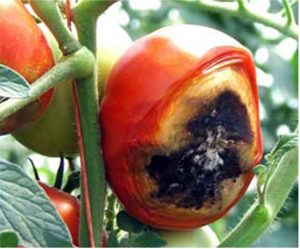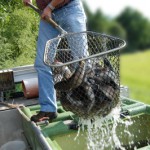 That nasty, dry sunken decay on the blossom end of your tomato plant got you frustrated? You’ve staked, tied, and babied those plants like a pro. Unfortunately, those red beauties have probably been stricken with blossom end rot. Don’t lose hope! We’ll lay out a few tips that alleviate and prevent this from happening to you.
That nasty, dry sunken decay on the blossom end of your tomato plant got you frustrated? You’ve staked, tied, and babied those plants like a pro. Unfortunately, those red beauties have probably been stricken with blossom end rot. Don’t lose hope! We’ll lay out a few tips that alleviate and prevent this from happening to you.
First of all, blossom end rot can happen to any fruit, but we get more questions about tomatoes. End rot is an issue with the first fruits of the season, after wet or dry periods.
What does blossom end rot look like?
It first appears as brown water-soaked spots on the bottom of the tomato, and then ultimately turns into a black, leathery mess. It can happen at any time during the maturity of the fruit, but it is most common during the early harvest period.
What causes blossom end rot?
Insufficient calcium in the growing tissue of the tomato is your culprit. Calcium is taken up by the root system and pushed throughout the stems, leaves, and fruit. Sometimes that calcium settles out and it doesn’t make it to the growing tomato. Leaving you with plenty of calcium in your soil, and none in your growing fruit.
Calcium travels through the roots, vines, and fruits via water. So, when you have inconsistent moisture through the growing season, the stream of calcium is interrupted.
How do you prevent blossom end rot?
- Grow tomatoes in well-drained soil with a pH between 6.5-7.5.
- Apply fertilizer and lime as recommended by a soil test.
- Apply fertilizer low in nitrogen and high in phosphate like 10-20-10; this will help reduce the potential for end rot.
- Avoid root pruning by deep cultivation, especially after fruit set and during dry periods.
- Stay consistent when it comes to irrigation. Tomatoes need about 1-1.5 inches of water per week, either by irrigation or rainfall.
- Remove infected, rotten, or damaged fruit as soon as you notice them. Blossom end rot does not move from plant to plant or fruit to fruit. So, later tomatoes on the same plant may be just fine. This also means fungicides are useless in controlling this disorder.
I hope these tips help you achieve tomato growing success and avoid blossom end rot this growing season. Please visit any of our Farmers Cooperative locations for plants, supplies, and a gardening tip or two.
*Soil samples are usually done for free through your local county extension office.
Source: Matt Crabtree – Farmers Cooperative


